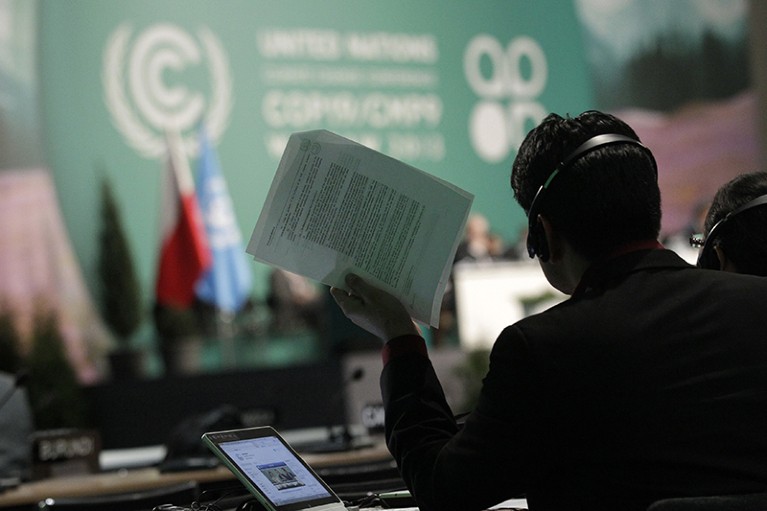
The 2013 United Nations Climate Change Conference in Warsaw.Credit: Kacper Pempel/Reuters
The Secret Life of Science: How It Really Works and Why It Matters Jeremy J. Baumberg Princeton University Press (2018)
Experienced scientists have two core tasks. One is to produce great research. The other is to encourage people to think about how to do great research. Jeremy Baumberg has done the first; now he tries his hand at the second. He was a professor at 30 and is a fellow of the Royal Society. He is well-funded and experienced internationally, in both the private sector (at IBM and Hitachi) and the public realm (the University of Cambridge, UK), running nanotechnology groups with a focus on nanophotonics. As The Secret Life of Science shows, he’s in an excellent position to create a refreshing description of how research “really works and why it matters”.
In this solid, coherent and thoughtful study, Baumberg deploys an ecosystem model to describe research processes. (I was once an ecologist and know the usefulness of such models in capturing resource flows, competition, behavioural parallels and so on.) He clarifies the dynamics of publishing, conferences, media, translation to industry and careers, and provides a broad summary of influence.
The chapter on publishing will strike a chord for many Nature readers. He touches on how scientists must “clamor for attention”, driving them to publish often and in high-impact journals. He notes information from, and influence of, publication metrics. But he doesn’t discuss concerns about their misuse, as captured in the Declaration on Research Assessment launched in San Francisco, California, in 2012 and endorsed this year by the UK research councils. Nor does he mention the Leiden Manifesto on how to do things better (D. Hicks et al. Nature 520, 429–431; 2015).
Baumberg’s take on conferences might be less familiar. He asserts that the conference system dominates science. Does it? Although I agree with him that topical conferences are the most valuable for interaction, I’m dubious about their importance in the life and social sciences, at least for leading researchers. Perhaps we need a new impact indicator for that part of the ecosystem?
The book offers intriguing insights into the grant system (the tensions around how to set goals and distribute funding for science) and technology-transfer problems (innovation in established enterprises). But Baumberg’s vignettes — such as one on how established technology suppressed innovation at photography company Kodak — whetted my appetite for more detailed examples. Elsewhere, he draws attention to the policy challenge of training too many young researchers with too little funding per head, and comments on the over-supply of postdocs, in an echo of UK and US reports. How this can be managed, and how the situation is different in China — still in a growth phase — deserved much more space.
Baumberg’s recommendations for change are admirably succinct. Rightly, in my view, he tackles the overabundance of scientists and the benefits of constraining the pipeline. He proposes changes in funding distribution to restore diversity of ideas. He calls for better conferences attended by fewer people, and for improving tools through artificial intelligence and customized knowledge retrieval. He commends open access and open data, and proposes open instrumentation.
I was pleased to see that he enjoins leaders to nurture more-considered postdoctoral careers and to ensure that organizations manage people and projects more consistently. The latter point came up repeatedly in an as-yet unpublished survey for the advocacy group Universities UK on international collaboration. A key benefit of the European framework research-funding programmes has been the establishment of sound, consistent regional bureaucracy.
I enjoyed much of The Secret Life of Science, but it has idiosyncrasies. It is definitely not about the whole research base. Baumberg suggests bringing in social scientists to help identify scientific ecosystem services (intuition, for example), yet he fails to point out that social scientists such as Robert K. Merton have influenced the structure and practice of science in the United States.
I wondered who this book is for. It lacks the accessible style and high-quality graphs and images that would be useful to the aspiring scientist. And for the academic, it has not a single reference, so it is impossible to follow sources and difficult to distinguish between Baumberg’s original thinking and what he draws from reading. I found this problematic in sections touching on my research areas of tracking collaboration and impact through publishing. Some statements, such as those on citation patterns, are highly simplified, and there is no link to the substantial research background or reports such as The Metric Tide (2015). Elsewhere, the very extensive work on ‘the science of science’ in many countries, particularly that from the US National Science Foundation, is not recognized.
Baumberg sees The Secret Life of Science as providing a bird’s-eye view that “scientists and public alike have lacked”. I found his perspective more particular than that. But that does not detract from the validity of the narrative, nor the high value of the final discussion.

 What makes teams tick
What makes teams tick
 University presses adapt
University presses adapt








